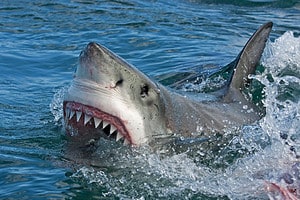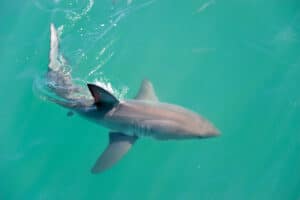Basking sharks are amazing creatures found throughout the world’s oceans. They are not only the second largest fish in the world but also the only shark to passively filter feed. While not everything is known about the basking shark due to its secretive nature, there are plenty of interesting facts to find out about this species. Here are eight basking shark facts to blow your mind and show how incredible this shark can be.
1.) Basking Sharks Can Weigh More Than 10,000 lbs
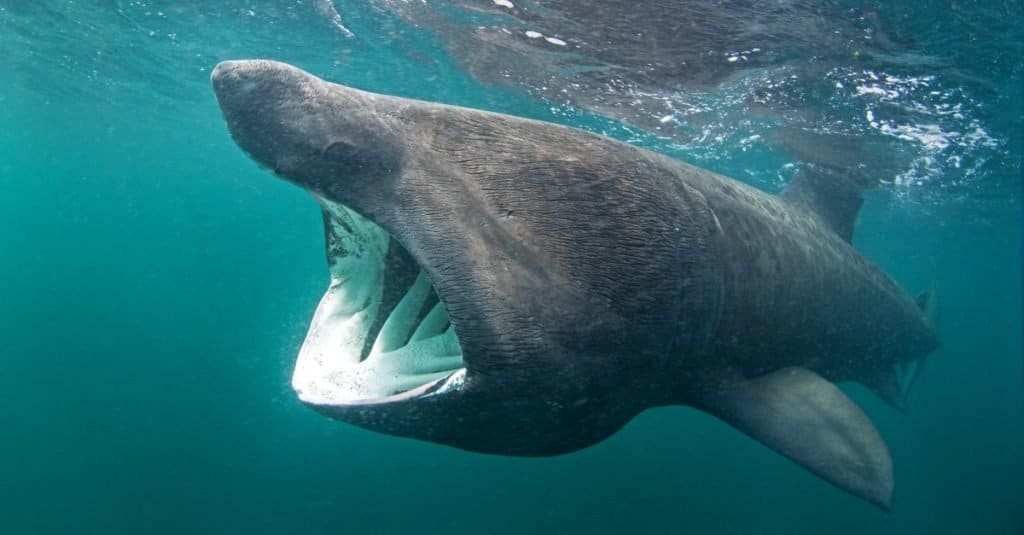
A basking shark, Cetorhinus maximus, swimming near Coll Island, Scotland. The most impressive feature of the basking shark is its mouth, which opens up to 1 meter wide.
©Martin Prochazkacz/Shutterstock.com
Being the second-largest fish in the world, basking sharks are expected to be large. But did you know the average weight of a full-grown basking shark is estimated at 10,260 lbs? To put that into perspective that is the same weight as five average great white sharks put together.
It’s no wonder they weigh so much when you consider they can reach a length of up to 12m (39 feet) Everything about the basking shark is larger than life from its large gills, powerful crescent-shaped tail, and giant gaping mouth.
The largest basking shark ever recorded was found in 1851 in Canada and is estimated to have weighed up to 36,000 pounds! That’s 7.2 times the size of the largest great white shark ever recorded.
2.) Despite Their Massive Size Basking Sharks Can Go Jump Out Of Water
With their slow movement and large size, you think it would be a challenge for this species to catch air. Despite that, there are many instances seen where this ginormous shark breaches the water like a small dolphin.
Basking sharks can jump 1.2 meters (4 feet) out of the water while reaching a speed of 18kmp (11.1mph). Breaching is thought to signal other sharks and clean parasites off their skin. It is awesome to see such a large creature jump out of the water like a species much smaller than it.
3.) Basking Sharks Can Be Extremely Smelly
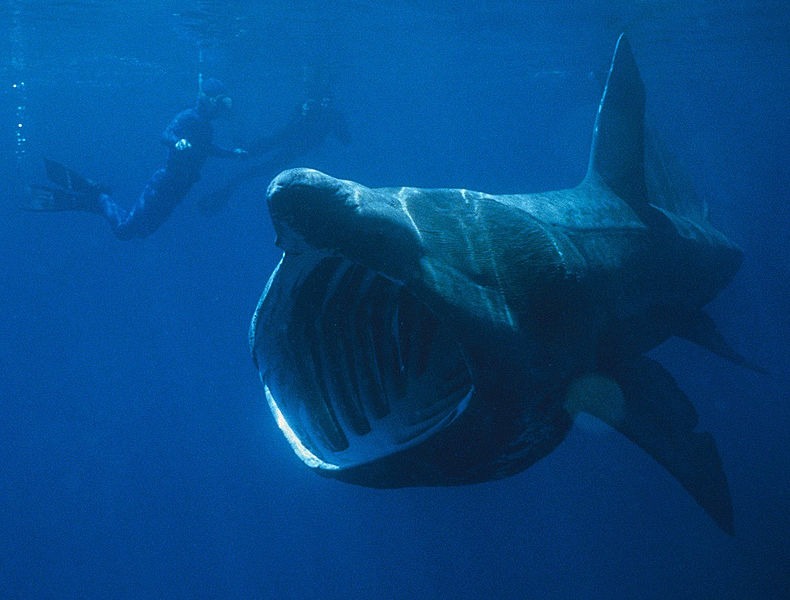
Basking Shark with mouth open next to a diver
©Chris Gotschalk / Public Domain, from Wikimedia Commons, the free media repository – Original / License
Basking sharks are covered in thick mucus. This powerful mucus can not only corrode nets but carries an extreme stench that some say is capable of being smelled above water. The smelly slime covering their body is used to protect them from aquatic parasites like lampreys.
4.) The Liver Of The Basking Shark Makes Up 25% Of Their Weight
The basking shark’s liver makes up 20 to 25% of its entire body weight. Their liver is important in regulating their buoyancy and energy use. Their liver contains 60% fat which helps this large fish stay afloat.
Throughout human history, this shark was hunted for its giant livers that contained heaps of shark liver oil. The oil is used for medical treatments and cosmetic items, and the collection of it has been a factor in why this species has become endangered.
5.) Basking Sharks Have A Total Of Around 1,500 Teeth
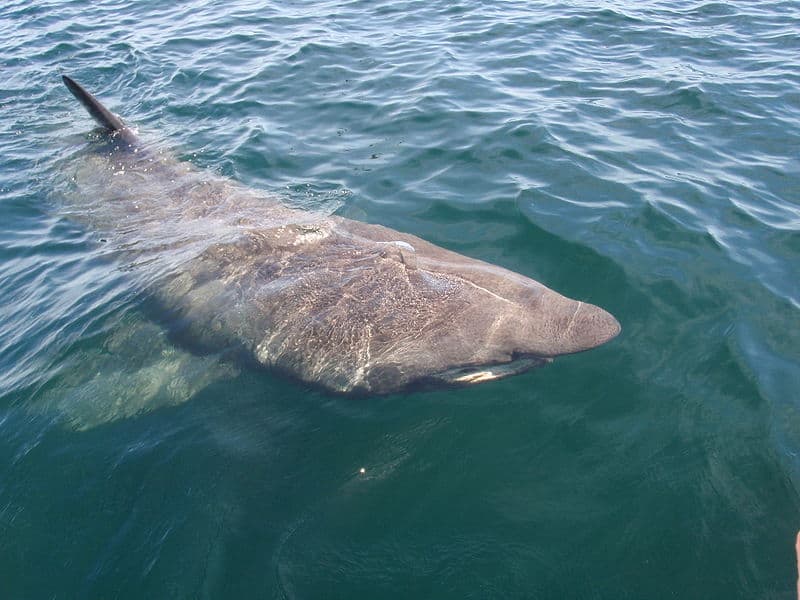
Basking shark (Cetorhinus maximus)
©rossbeane, CC BY-SA 2.0, via Wikimedia Commons – Original / License
The basking shark’s largemouth reaches up to 1 meter (3 feet) in length and can contain over 1,500 teeth. These teeth are not used for chewing and are small and conical. They have 6 rows of teeth on their upper jaw and 9 rows on their lower jaw. Each row contains around 100 teeth which are 5 to 6 mm in length. One use for their small teeth is to hold onto partners while mating. While the teeth total of basking sharks is impressive, their filter feeding brethren whale sharks eat using 3,000 teeth!
6.) It Is Common For Basking Sharks To Travel Over 3,000 Kilometers
Basking sharks are highly migratory and will travel thousands of miles in winter and dive into the depths of the ocean to feed off plankton. One basking shark that was tracked traveled 9,589 km (5,958 miles) and dove up to depths of 1,264m. The reason for migration is unknown by scientists but some reasonable theories include mating, foraging for food, and moving to its preferred temperature of the water. Tagging technology has given insight into this species that was previously unattainable and will allow scientists to fully piece together their mysterious travels.
7.) Basking Sharks Can Travel In Groups And One Was As Big As 1,400 Sharks
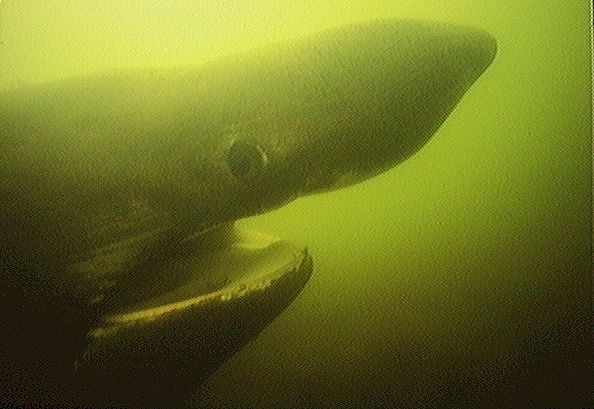
Head of a Basking Shark (Cetorhinus maximus) in the deep
©NOAA’s Northeast Fisheries Science Center / Public domain, from Wikimedia Commons, the free media repository – Original / License
Basking sharks are solitary but sometimes groups of sharks can form large schools with up to 100 members. On November 5, 2013, a large group was spotted off the coast of New England which had 1,398 sharks within an 11-mile (17.7 km) radius of each other. Numbers this high have never been seen together before and are a positive sign for the species. Large amounts of plankton in the water were thought to be the why reason such a large feeding frenzy formed.
8.) The Gestation Period For Basking Sharks Is Up To 3 ½ Years
The basking shark’s gestation period can last for around 3 ½ years and is the longest of any vertebrate. They give birth to live young which hatch from eggs inside their uterus. As opposed to some species like the whale shark who can give birth to hundreds of babies, the basking shark only gives birth to a few live young. Their long gestation period along with the amount of young they give birth to is a reason why it’s challenging to recover the population of this endangered species.
9.) Basking Sharks Can be Mistaken for Dinosaurs!
Ever heard of the Loch Ness Monster? Its supposed to be a plesiosaur, which was a type of long-necked predatory marine reptile from the times of dinosaurs. Beyond the Loch Ness Monster, there have been other reports of plesiosaurs across the world, such as one reported on a Japanese trawler in 1977 that has led to significant attention.
So, are ancient creatures from the time of dinosaurs lurking in the ocean? The truth is that DNA analysis has shown that this trawler actually had the carcass of a basking shark rather than a plesiosaur. When basking sharks decay, their bodies decay in a way where their head remains intact while the midsection of their body withers. This leads to an appearance similar to ancient reptiles from the sea. So, if you hear about a long-necked dinosaur washing up from the sea, the truth is its probably just a basking shark!
The photo featured at the top of this post is © Chris Gotschalk / Public Domain, from Wikimedia Commons, the free media repository – License / Original
Thank you for reading! Have some feedback for us? Contact the AZ Animals editorial team.




